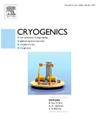Analysis of the critical current and electromagnetic forces of HTS segments in multiple pairs of current leads used in the current lead box of a fusion reactor
IF 1.8
3区 工程技术
Q3 PHYSICS, APPLIED
引用次数: 0
Abstract
The high-temperature superconducting current leads (HTS CLs) used in fusion reactors require multiple HTS CLs to be placed inside the current lead box (CLB) of specified dimensions. Each HTS CL not only carries a large current but also has very high safety requirements. This study, based on the first generation HTS tapes (Bi-2223/Ag-Au), analyzed the critical current distribution of a 60 kA HTS CL and evaluated optimal power supply configurations for eight HTS CLs within the CLB. It also determined the optimal distance of each lead from the center of the CLB. Through ANSYS APDL calculations, we first obtained the critical current distribution of each panel of a single CL. The analysis results indicated that the HTS segment has a current carrying capacity of 78 kA at 65 K. Secondly, the optimal power supply option adopted a positive–negative alternating approach. When the distance is 1200 mm, the total current carrying capacity of the eight CLs is 605 kA, with relatively minor differences among the minimum panels of each lead, and the electromagnetic forces for each current lead were all below 1000 N. In addition, the relationships of the critical currents, surface areas of the CLB and electromagnetic forces of eight CLs with distance were obtained. Based on the above analysis, the distance of each lead from the center of the CLB was determined to be at least 800 mm.
核聚变反应堆引线箱中多对引线中高温超导段的临界电流和电磁力分析
用于核聚变反应堆的高温超导电流引线要求在规定尺寸的电流引线盒内放置多个高温超导电流引线。每个高压超导换能器不仅承载大电流,而且对安全性的要求也很高。本研究基于第一代高温超导带(Bi-2223/Ag-Au),分析了60 kA高温超导带的临界电流分布,并评估了CLB内8个高温超导带的最佳电源配置。它还确定了每个引线到CLB中心的最佳距离。通过ANSYS APDL计算,首先得到了单个CL各面板的临界电流分布。分析结果表明,高温超导段在65 K时的载流能力为78 kA。其次,最优供电方案采用正负交变方式。当距离为1200mm时,8个CLs的总载流容量为605ka,各引脚最小面板之间的差异较小,各电流引脚的电磁力均小于1000n。此外,得到了临界电流、CLB表面积和8个CLs的电磁力随距离的关系。根据上述分析,确定每根引线与CLB中心的距离至少为800 mm。
本文章由计算机程序翻译,如有差异,请以英文原文为准。
求助全文
约1分钟内获得全文
求助全文
来源期刊

Cryogenics
物理-热力学
CiteScore
3.80
自引率
9.50%
发文量
0
审稿时长
2.1 months
期刊介绍:
Cryogenics is the world''s leading journal focusing on all aspects of cryoengineering and cryogenics. Papers published in Cryogenics cover a wide variety of subjects in low temperature engineering and research. Among the areas covered are:
- Applications of superconductivity: magnets, electronics, devices
- Superconductors and their properties
- Properties of materials: metals, alloys, composites, polymers, insulations
- New applications of cryogenic technology to processes, devices, machinery
- Refrigeration and liquefaction technology
- Thermodynamics
- Fluid properties and fluid mechanics
- Heat transfer
- Thermometry and measurement science
- Cryogenics in medicine
- Cryoelectronics
 求助内容:
求助内容: 应助结果提醒方式:
应助结果提醒方式:


